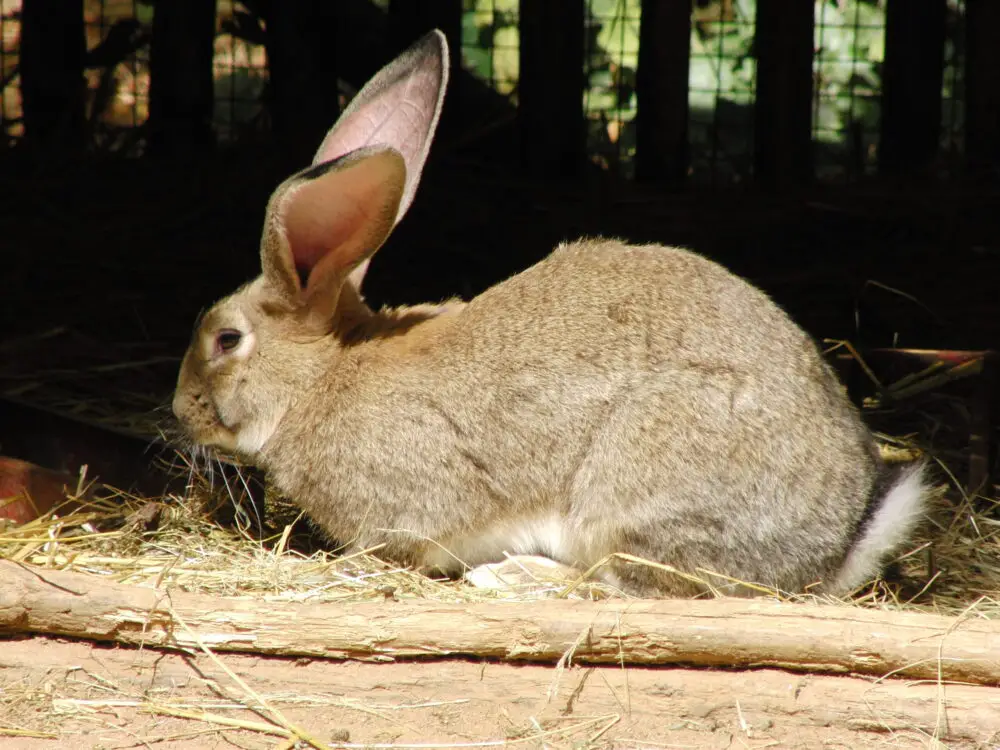Basic Appearance:
Flemish giants are the largest breed of rabbit in the United States. They are 13 pounds and up, and at least 21 inches long. They have a graceful semi arch body type, and are the gentle giants of the rabbit world.
History, Temperament, and Common Uses:
Small breeds of rabbits are common now, but large rabbits were very popular in the late 19th to early 20th century. The Flemish giant is said to have originated in Flanders, Belgium. It is possible that some giant rabbits brought to Europe from South America may have been used in the development of the Flemish breed. The Flemish giant was very desirable for meat production, and was well established by the 20th century. In 1915 the first U. S. Flemish giant rabbit club was formed.
Flemish giants are calm, gentle, and friendly. Once you are used to their large size, they are easy to handle.
Flemish giants are a fancy breed, meaning they are raised primarily for showing and pets. They do not make good meat rabbits, as they eat a lot and are big boned.
Grooming, Care, and Additional Notes:
Like other breeds with rollback coats, the Flemish needs little grooming. A once-a-week brushing will keep your Flemish giants looking nice. When they are molting more grooming may be necessary.
Some breeders say that Flemish giants have trouble with sore hocks. Most should be fine with wire floors, but if your rabbits are having problems with sore hocks, you can give them plastic resting mats that are made to fit wire floors, or you can give them a piece of wood to sit on.
It is best to keep the colors pure when breeding, mixing them can have a detrimental effect on the varieties.
Flemish Giant At A Glance…
Recognized Varieties:
Black, blue, fawn, light gray, sandy, steel gray, and white. Note that sandy is a chestnut agouti, light gray is a chinchilla, and steel gray is a black silver-tipped steel.
ARBA Body Type:
Semi Arch
Approximate Size:
13 to 14 pounds and up. Flemish giants over 20 pounds are possible.
Important Things to Look for When Buying Show Stock:
Big Flemish are desirable, but balance is even more important. Balance means well proportioned. The head, ears, and legs should balance with the body. Long bodied rabbits should have longer heads, ears, and legs than a medium length rabbit. Flemish giants should wide enough to not be too narrow. The ear base of Flemish giants is very important, it should be full and heavy, giving the rabbit good ear carriage. Flemish giants should be heavy boned.
The body should be long, full, and powerful. The body arch should start just behind the shoulder blades, reach a high point over the hips, and sweep down to the tail. There should be a slight taper from the shoulders to the broader hindquarters. Hindquarters should be broad, massive, rounded, and full. The body should be well muscled and firm. Does may have a large, even dewlap.
Head should large and broad. Ears should be six inches long or more in rabbits over junior age. Flemish are gentle giants, they should have a “reposeful expression” of the eye. Legs should be powerful and straight. Tail should be held erect and balance with the body. Fur should be rollback, bright, and dense.
Things to Avoid:
Rabbits that are not balanced. Pinched hindquarters, fat rabbits, narrow body. Short body under 20 inches on seniors or lack of body arch is a disqualification. Thin ears or weak ear base. Ears that turn over at the tip or are less than 5 1/2 inches are a disqualification. Medium bone is a fault. Fine bone, short legs, cow hocks, flat feet, weak ankles (bending at the ankle affecting straightness of forelegs), and mismatched toenails are disqualifications. Thin, very short or very long fur or a soft coat.

